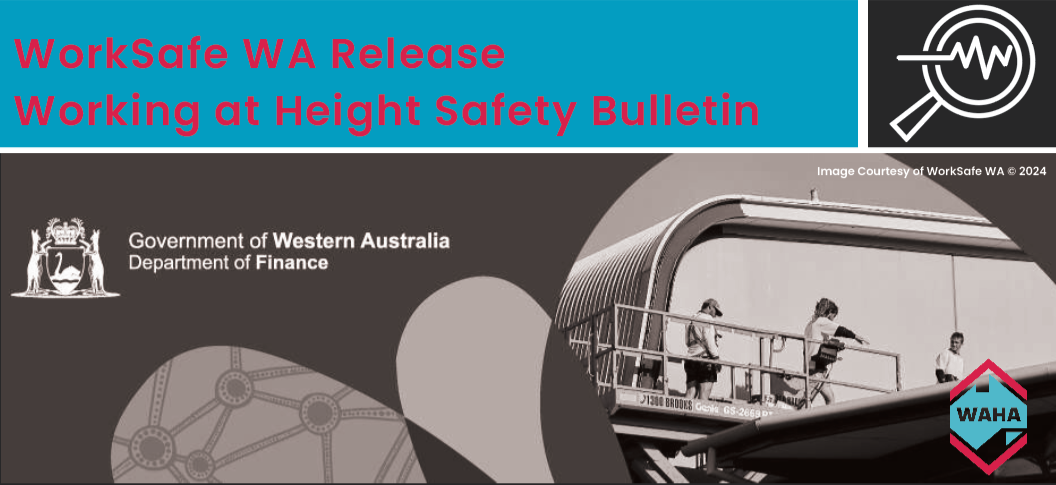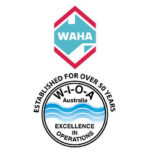
| Safety is everyone’s business |
| As October is National Safe Work Month, we’d like to introduce our new Working at Heights Safety Bulletin, which will provide relevant updates and information to ensure all contractors and customers remain safe and well. |
“Working at heights is a high-risk construction activity, and falls from heights are a leading cause of death and serious injury in Australia” Safe Work Australia” National Safe Work Month provides a timely reminder that working at heights can be a dangerous activity. During October (and beyond), Finance encourages all contractors to review their working at heights processes to ensure they are compliant with current legislative requirements. Finance would also like to remind contractors that all incidents and near misses must be reported to your Finance Representative. Assessing risk If working at heights can’t be eliminated, the team conducting the works must complete a risk assessment before starting work. Prior to commencing any works at height, and as part of the WorkSafe risk management planning process, a Person Conducting a Business or Undertaking (PCBU) must: Identify the hazards. Assess the risks. Control the risks. Regularly review control measures. Risk management process  Who is responsible? During the risk management process, PCBUs should consult with workers and other PCBUs who have a work health or safety (WHS) duty in relation to the same matter, so far as is reasonably practicable. On construction sites, there’s often more than one PCBU involved in the same activities or workplace and they may have shared responsibility for the same WHS matter. This responsibility extends to the management and supervision of subcontractors engaged by builders as subject matter experts on construction sites. Hierarchy of controls: mitigating risks When mitigating falls from height risks, the hierarchy of controls should be used to assess the risks associated with the task. The controls are listed are from most (Level 1) to least (Level 3) effective. The best strategy may involve one or more controls. Hierarchy of controls  Steps to controlling the risk of falls Part 4.4 of the Work Health and Safety (General) Regulations 2022 provides information on controlling the risk of falls using the following steps: 1. Elimination The most effective level of control is to remove the risk. Work at heights should be avoided if reasonably practicable.Do as much work as possible from the ground. 2. Substitution, isolation, and engineering: If working at heights can’t be eliminated, works should be carried out on a solid construction. A solid construction has: -: A surface that can support all people and things that may be located or placed on it. -: An even surface and gradient that’s easy to negotiate. -: Barriers to prevent a fall around its perimeter and any openings -: A safe way to enter and exit. Persons conducting a business or undertaking must put in place a safe system of work that may include, as far as is reasonably practicable a fall prevention system such as: -: safety mesh -: elevated work platforms -: guard rails -: platforms -: walkways and skylight protection -: permanently mounted stairways and ladder systems or roof access hatches -: a work positioning system, for example an industrial rope access system and fall-arrest system. 3. Administration and Personal Protective Equipment (PPE): A Working at Heights Permit may be used as a control measure to ensure the works at height are planned to include: -: safe work method statements -: information and training including: high risk licenses signage using the correct personal protective equipment. -: administrative and PPE controls are the least preferred method of protection because they do not provide a physical or positive means of protection. |
| Additional information For additional information, please access: Code of practice – Construction work Code of practice – Managing the risk of falls at workplaces Code of practice – Safe design of structures Information sheet – Reasonably practicable Information sheet – Managing the risk of falls at workplaces Work Health and Safety Act 2020 |
| Safety Share – Case Study Case studies are a great way to learn from experience. Please share the below with all workers for their knowledge and learning. Esperance business owner jailed after pleading guilty to gross negligence that led to the death of a worker In March 2020, two workers employed by a regional PCBU were installing roofing on a shed at a farm in Esperance. Severe winds lifted one of the roofing sheets being installed. One worker fell around 9 metres from the apex of the shed, suffering fatal injuries. The other worker fell approximately 7 metres and suffered several fractures to their ribs, pelvis, neck, and wrist. No high-risk work licenses for activity or safety harnesses were in place. The PCBU allowed its workers to undertake construction work without a construction induction training certificate, commonly known as a ‘White Card’). ABC News reported that the prosecutor told the Esperance Magistrate’s Court there was a, “failure to implement safety systems and supervise for a long period of time”, that the risk of an incident of this type occurring was not low and “there was a knowing acceptance of the danger”. The prosecutor told the court the director was, “well aware of the risk”. The director had been in construction for 30 years, with 20 years of experience in building sheds. The director of the PCBU overseeing the works was sentenced to 8 months in jail with a remaining 18 months to be suspended for a period of 12 months. The PCBU was fined $605,000 for safety breaches, and the director was instructed to pay a personal fine of $2,250 for operating a crane without a license. The director did not do everything reasonably practicable to ensure the workers were not exposed to harm due to the hazard of working at height. |






